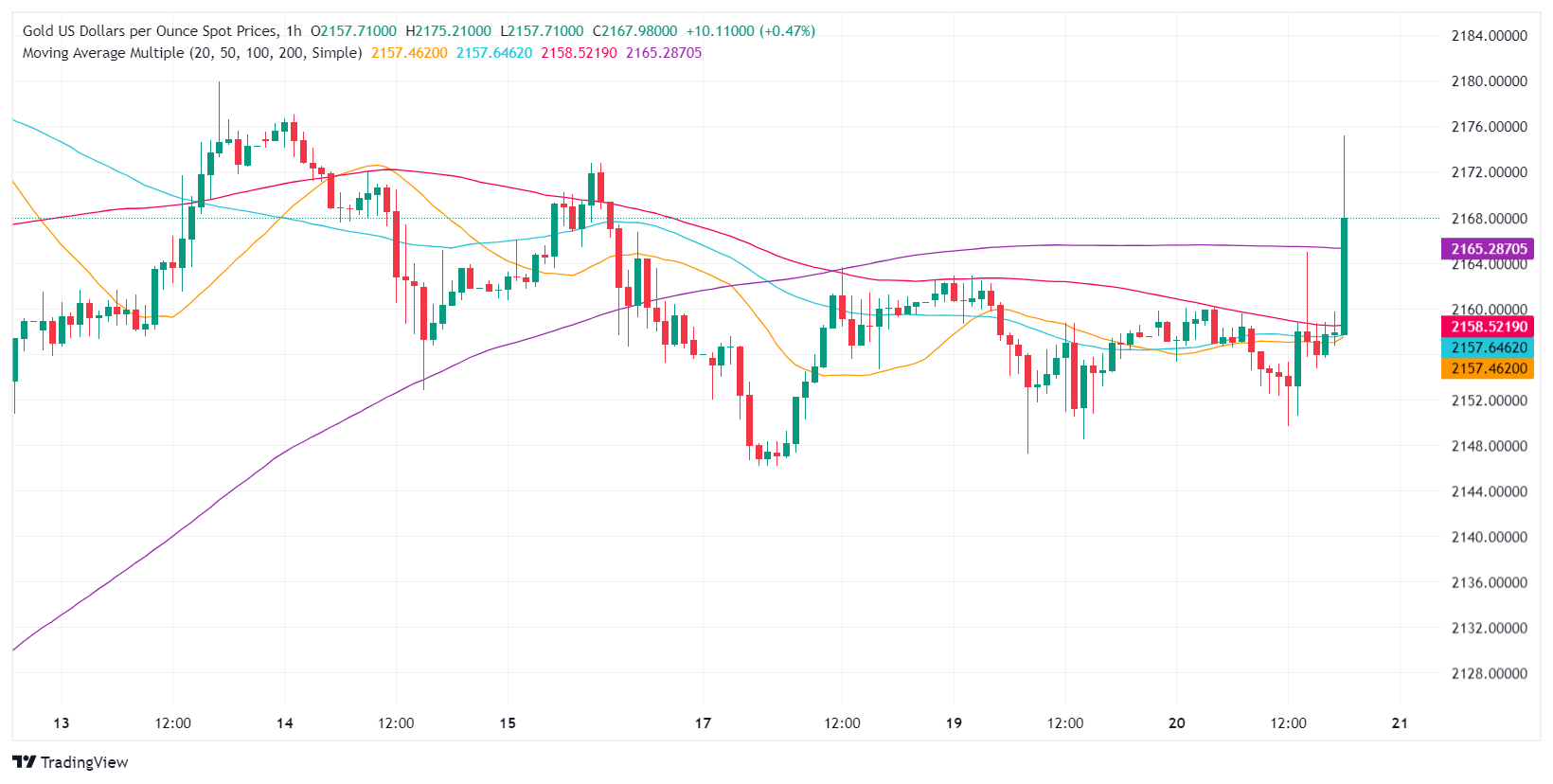- Gold rebounds and trades between $2,150 and $2,180 after the latest monetary policy meeting of the Federal Reserve.
- The Fed keeps interest rates stable, but adjusts its long-term forecasts for 2025, highlighting the challenges posed by inflation.
- Economic projections show an optimistic view for GDP growth in 2024, with slightly elevated underlying inflation expectations.
- The 10-year US Treasury yield declines slightly, contributing to the dollar's decline and supporting gold's bullish move.
The price of Gold is rebounding strongly, as the Federal Reserve decided to keep rates unchanged, but revised upward the Federal Funds Rate (FFR) forecasts for 2025. At the time of writing, the XAU/USD It is trading volatile around the $2,150-$2,170 zone, recording gains.
The US central bank has kept rates unchanged at 5.25%-5.50% and has continued to reduce its balance sheet at the same pace since May 2023. In its statement, Fed officials underlined the strength of the US economy and the strength of the labor market. They have acknowledged progress on inflation, but have also stressed that the work is not yet finished. They have stated that the risks to achieving their dual mandate are becoming better balanced, and that they will continue to base their decisions on data.
After two months of surprisingly high inflation reports, the Federal Reserve modified its monetary policy expectations for 2025, although for 2024 the median remained at 4.6% as in December. However, they revised the FFR upward from 3.6% to 3.9% in 2025. Other figures were updated:
- The Gross Domestic Product (GDP) for 2024 was revised to 2.1%, up from 1.4% in December.
- The unemployment rate was not revised as it is expected to remain at 4.0%, down from 4.1% previously.
- The personal consumption expenditure (PCE) price index target was unchanged and remained at 2.4%, while the underlying PCE is estimated to end 2024 at 2.6%, up from 2.4% previously.
Following the release of the data, Gold hit a daily high of $2,175.11 and remains near session highs. The 10-year US Treasury yield drops two basis points to 4.275%, while the dollar is under pressure.
Daily Market Summary: Gold Steady on US Dollar Weakness
- The Federal Reserve's December Summary of Economic Projections showed that policymakers expected GDP in 2024 to be 1.4% and the unemployment rate to be 4.1%.
- As for inflation numbers, the underlying personal consumption expenditure (PCE) price index, favored by Fed Chair Jerome Powell for tracking inflation, is expected to fall to 2.4% in 2024, aligning with the general forecast of the PCE.
- The December dot plot suggested that Fed officials expected the FFR to end up at 4.6%, down from 5.1%. However, if the median moves to 4.8%, that would imply that Powell and company expect two rate cuts by 2024.
- The latest US economic data produced mixed readings on business activity, making it difficult to predict the pace of economic slowdown in the US. The labor market has shown signs of cooling, although the economy added more people to the workforce. active population than expected, while fewer people applied for unemployment benefits.
- Recent US inflation data showed that inflation on the consumer and producer sides surprised to the upside, suggesting that inflation is stronger than expected.
- In this context, Fed Chairman Jerome Powell's statements before the US Congress at the beginning of the month, suggesting that the Fed would begin to cut funding costs, were justified. However, last week's inflation figures and retail sales data prompted a repricing of the Fed's rate cut bets, aligning with the US central bank's vision of 75 basis points of easing by the end of 2024.
- According to CME's FedWatch tool, expectations for a rate cut in June stand at 64%, up from 72% a week ago.
Technical Analysis: Gold Traders Push XAU/USD North of $2,150

The price of X AU/USD is around $2,150 unchanged before the FOMC decision. A moderate bias could open the door to a rally that would cause a jump in Gold prices, opening the door to challenging the all-time high (ATH) at $2,195.15. If tested again, it would reach $2,200.
On the other hand, if the gold spot price falls below $2,150, we will have to wait for a break below the December 3 high, exposing the March 6 low of $2,123.80, followed by $2,100. .
Frequently asked questions about the Fed
What does the Federal Reserve do and how does it affect the dollar?
The monetary policy of the United States is directed by the Federal Reserve (Fed). The Fed has two mandates: achieving price stability and promoting full employment. Your main tool to achieve these objectives is to adjust interest rates.
When prices rise too quickly and inflation exceeds the Federal Reserve's 2% target, it raises interest rates, raising borrowing costs throughout the economy. This translates into a strengthening of the US Dollar (USD), as it makes the United States a more attractive place for international investors to place their money.
When inflation falls below 2% or the unemployment rate is too high, the Federal Reserve can lower interest rates to encourage borrowing, which weighs on the greenback.
How often does the Federal Reserve hold monetary policy meetings?
The Federal Reserve (Fed) holds eight meetings a year, in which the Federal Open Market Committee (FOMC) evaluates the economic situation and makes monetary policy decisions.
The FOMC is made up of twelve Federal Reserve officials: the seven members of the Board of Governors, the president of the Federal Reserve Bank of New York, and four of the eleven presidents of the regional Reserve banks, who serve for one year on a rotating basis.
What is Quantitative Easing (QE) and how does it affect the USD?
In extreme situations, the Federal Reserve can resort to a policy called Quantitative Easing (QE). QE is the process by which the Fed substantially increases the flow of credit into a clogged financial system.
It is a non-standard policy measure used during crises or when inflation is extremely low. It was the Fed's weapon of choice during the Great Financial Crisis of 2008. It involves the Fed printing more dollars and using them to buy high-quality bonds from financial institutions. QE usually weakens the US dollar.
What is Quantitative Tightening (QT) and how does it affect the US Dollar?
Quantitative tightening (QT) is the reverse process of QE, whereby the Federal Reserve stops buying bonds from financial institutions and does not reinvest the capital of the maturing bonds it has in its portfolio to buy new bonds. It is usually positive for the value of the US Dollar.
Source: Fx Street
I am Joshua Winder, a senior-level journalist and editor at World Stock Market. I specialize in covering news related to the stock market and economic trends. With more than 8 years of experience in this field, I have become an expert in financial reporting.







